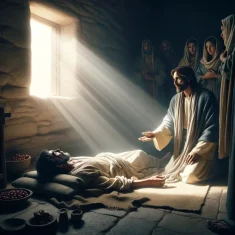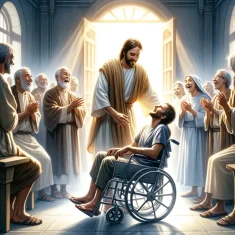
An image capturing a serene, ancient Middle Eastern town under a bright, clear sky where a group of diverse individuals gather around a humble home with expressions of anticipation and reverence.
In the heart of a bustling ancient Middle Eastern town, amidst the ordinary days filled with the simple lives of its inhabitants, a miraculous event unfolded—a testament to faith, compassion, and divine intervention. This narrative explores one of the most compelling miracles performed by Jesus: the healing of a paralytic man. The story, rich in detail and imbued with spiritual significance, offers insights into the nature of miracles, the power of faith, and the limitless compassion of Jesus.
A Gathering of Faith
This gathering, centered around the humble home that played host to Jesus, encapsulates a moment of profound communal faith and expectation. The news of Jesus’ arrival in their midst had ignited a spark of hope among the people, drawing them together in a shared anticipation of witnessing something miraculous. This was a community on the brink of witnessing the tangible manifestation of divine power, their eagerness palpable, a testament to the stories of healing and transformation that seemed to follow Jesus wherever he went.
In this charged atmosphere, the story of four friends emerges as a powerful emblem of faith in action. Their dedication to their paralyzed companion is a reflection of the deep bonds of friendship and loyalty that transcend personal comfort and convenience. Faced with the physical barriers that prevented their friend from reaching Jesus, they embodied a resilience and ingenuity that spoke volumes of their belief in Jesus’ ability to heal and restore.
Their journey to the gathering was motivated by more than just the hope for physical healing; it was a pilgrimage fueled by faith in the transformative potential of Jesus’ presence. The barriers they encountered—crowded spaces, skeptical onlookers, the physical limitations of their friend—did not deter them. Instead, these challenges served to amplify their determination, showcasing the depth of their belief that an encounter with Jesus could change everything.
The action of carrying their friend to Jesus, finding a way to bring him into Jesus’ presence despite the obstacles, highlights a remarkable faith. It wasn’t a passive belief but an active, dynamic faith that propelled them to seek out innovative solutions. Their efforts culminate in a vivid demonstration of communal support and solidarity, illustrating how faith can drive individuals to extraordinary lengths on behalf of those they care for.
This moment, with its blend of anticipation, faith, and communal effort, sets the stage for a significant encounter with the divine. It reminds us that the journey towards healing and transformation often requires more than individual belief; it calls for the support and faith of a community that is willing to bear one another’s burdens, literally and figuratively. In this gathering around a humble home, we see a microcosm of faith in action, where the collective hope and determination of a community converge in a powerful display of what it means to come together in expectation of the miraculous.
Through the Roof

An illustration showing the inside of a humble Middle Eastern home, where Jesus extends his hand toward a paralytic man lying on the floor, surrounded by a small crowd in silent awe.
In the face of insurmountable odds, the friends’ decision to lower their paralyzed companion through the roof into Jesus’ presence is a testament to the lengths to which faith can drive human action. Their plan, marked by both faith and audacity, was not just a logistical solution to an overcrowded space but a profound statement of belief. It epitomized a determination to overcome both physical and societal barriers, reflecting a deep conviction in the healing power of Jesus and an unwavering commitment to securing that opportunity for their friend, no matter the cost.
This bold maneuver required more than just physical effort; it demanded a willingness to defy conventional norms and expectations. In a society where respect for property and social order held significant value, the act of dismantling a roof to facilitate an encounter with Jesus was radical. Yet, it was this very radicalness that underscored the depth of their faith and the urgency of their mission. They operated under the belief that the chance for their friend’s healing and transformation justified their unconventional approach.
The imagery of lowering the paralyzed man through the roof directly into the midst of where Jesus taught is striking. It not only captures the physical descent from the roof to the floor but also symbolizes a piercing through the layers of doubt, skepticism, and societal norms to reach a place of hope and possibility. This act became a visible manifestation of faith, a dramatic intervention that broke through the barriers that separated the man from his chance at a new life.
Moreover, this episode highlights the communal aspect of faith and healing. The friends’ actions serve as a reminder that the journey towards healing often involves the support and intervention of others. Their collective effort to bring their friend to Jesus illustrates the power of community and solidarity in navigating challenges and obstacles.
The decision to go through the roof, therefore, was more than a mere physical act; it was a declaration of faith, a moment of grace that bridged the gap between human desperation and divine provision. It vividly demonstrated that faith, when put into action, has the power to transcend the boundaries of the physical world and societal expectations, opening up avenues for divine intervention and miraculous transformation.
The Healing Touch

An emotional scene capturing the moment the paralytic man, now healed, stands up on his feet for the first time, supported by Jesus’ presence, with bystanders overflowing with joy and amazement.
The audacious act of lowering the paralyzed man through the roof directly into the presence of Jesus is a striking testament to the lengths to which faith will go. This remarkable scene, marked by determination and innovative problem-solving, sets the stage for one of the most profound moments of healing in the narratives surrounding Jesus’ ministry. The friends’ belief in Jesus’ ability to heal, coupled with their willingness to overcome any obstacle, paves the way for a miraculous encounter.
Inside the crowded home, Jesus’ response to their faith is immediate and transformative. His first words, “Son, your sins are forgiven,” reach beyond the man’s physical condition, addressing the deeper spiritual needs that often go unseen. This declaration of forgiveness is a powerful expression of Jesus’ understanding of holistic healing, recognizing that true restoration involves both the visible and the invisible, the body and the soul.
Following this spiritual absolution, Jesus commands the paralytic to rise, take up his mat, and return to his home. The simplicity of His command, juxtaposed with the complexity of the man’s condition, underscores the divine authority Jesus wields. The immediate obedience of the paralytic, standing and walking in front of all, serves as a vivid demonstration of Jesus’ power not only to forgive sins but to enact physical healing.
This moment of healing is multifaceted, showcasing Jesus’ compassion, authority, and the integral connection between faith and restoration. The paralytic’s healing becomes a visible sign of Jesus’ mission to bring salvation and wholeness to a broken world. It challenges the onlookers and us today to see beyond the physical manifestations of Jesus’ miracles to the deeper spiritual significance they hold.
Moreover, the astonishment of the crowd reflects a broader theme of revelation and response that pervades the narratives of Jesus’ life and work. The healing of the paralytic is not just for the benefit of the individual healed but serves as a testimony to all present, and to generations thereafter, of the transformative power of faith in Jesus. This event invites contemplation on the nature of faith, the barriers we face in seeking healing, and the profound ways Jesus addresses our deepest needs.
In this act of healing, we witness the convergence of faith, action, and divine compassion, offering a model of spiritual and physical restoration that transcends time. The story of the paralytic healed through the roof is a compelling narrative of hope, encouraging all to seek and trust in Jesus’ redemptive power, whatever obstacles we may face.